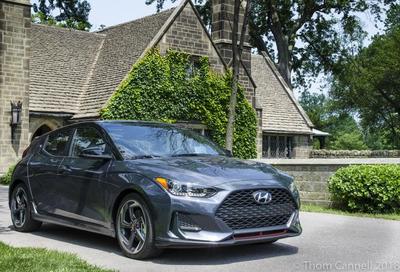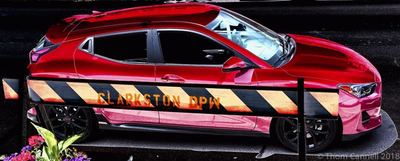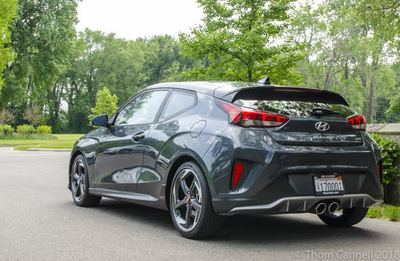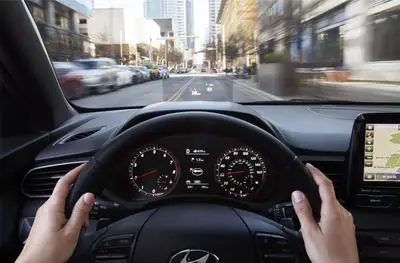2019 Hyundai Veloster Review By Thom Cannell - GTI Competitor? +VIDEO - It's E15 Approved!
2019 Hyundai Veloster Review
By Thom Cannell
Senior Editor
Michigan Bureau
The Auto Channel
Is the Second Generation Veloster a GTI competitor?
That’s the question we found ourselves asking as we hustled around interesting curves near Detroit last week. The stick-to-the-road was there and this was a relatively plush 2019 Veloster Ultimate It had no Michelin Pilot Sport summer-only tires, as are fitted to the Veloster-R. There was power in abundance from the 1.6-liter turbo (201 horses and 195 lb-ft of torque 1,500-4500 rpm), steering was go-kart sure, the seats had our back and the large dead pedal had our foot, and the DCT (dual clutch transmission) answered our every call. So???
Almost, not quite a GTI. Which is abundant praise, not even Hyundai brings up Golf as a competitive vehicle—it’s larger and more costly. Hyundai says Mini, Beetle and other very distinctive sporty cars are their competition. Our opinion: if you want the thrills of driving associated with driving a Mini, a GTI, a Focus ST or Subaru WRX and can’t afford one, the 2019 Hyundai Veloster offers a compelling alternative. Now, of course, you want detailș—like how the multi-link rear suspension affects your joy in driving.
There are only five models in this second generation of Velosters, beginning with the Veloster 2.0-liter with manual transmission. It’s priced at MSRP $18,500. Next up is the 2.0L Premium.
These entry models, which we haven’t yet driven, are not stripped-down, rather they are fully-featured with a 7” infotainment screen, forward collision warning, drive attention warning, lane keeping assist, torque vectoring for smooth power application, tinted glass, and a host of previously-premium safety features like stability management, blind spot warning (2.0L premium) and more.
The rest of the clan feature a 1.6-liter turbocharged, direct injected engine, the same multilink suspension, and add features—and benefits.
For the performance junkie there’s a Turbo R-spec model available with a six-speed manual transmission—only. It features a short-throw B&M shifter and high performance Michelin Pilot Sport summer-only tires. Should be quite the fun package, if you like to row the gearshift. If not, consider the Turbo or Turbo Ultimate. They are equipped with your choice of a six-speed automatic or seven-speed DCT. We tested the Turbo Ultimate in automatic and DCT, each provides paddle shifters—should you choose to use them.
The 2019 Veloster is new, top to bottom. Actually, the top itself is “faster”, with a more pronounced rake to the rear, now that Hyundai’s Kona has joined their ranks. The rake removes a tad of cargo volume, while delivering a more-sleek appearance. The three-door design, one sedan-type door for the driver and two on the passenger side, remains. This, Hyundai says, gives a highly personal sedan-like appeal to the driver, while retaining ease of entry for friends.
In front, the hexagonal face is wider, small scoops push air through beside the car to laminate airflow along the car, improving fuel economy. Some 2019 Velosters use a horizontal color bar to add textural highlight directly below the grille. Headlights are projector, with Ultimate models equipped with LED low beams. All Veloster models have LED tail lamps. At the rear hatch, beneath the wiper post, is a disguised push-button. That keeps the tail, with a very pronounced splitter-inspired blackout trim, tidy. Overall, the new car is a smidgen larger at 0.8-inches longer, and 0.4-inches wider. Inside, it feels comfortable for average and above-average height drivers and front-seat passengers.
Inside, you’ll find an asymmetric design theme makes it clear there is a space for passengering on one side, and a cockpit for the driver. All controls are oriented to the driver including an adjustable, and very bright, Head Up Display. It’s in color, with navigation, speed limit icons, digital tachometer and numerical speedometer. Very nicely done, by the way.
Seating surfaces and trim vary by model, from cloth to leather, with differing accents. Hyundai uses color hits of red accents, for instance on the steering wheel rim, shifter, around vents and between audio control knobs.
Every 2019 Veloster provides control over how the car drives and feels, with settings for Normal, Sport and Custom. We only tried Normal and Sport. There is a large difference between them. Sport, for instance, tightens up steering effort and on-center feel quite a bit, but not too much. Chassis damping also tightens, to the point where, on nasty back roads, it is uncomfortably firm. We’d use Sport for fun and on good roads, pushing the console button to Normal for freeways, leisure driving, and where roadways are potholed. It absolutely adds to the fun of driving.
Our Ultimate and Turbo each had Lane Keep Assist. It beeps, and we couldn’t find a way to stop the beeping. That limited its use on brisk two-lane driving. It would nudge the car back into the lane, but could be more assertive. (Later, we were told that there are controls in the Settings menu to control some aspects, like firmness.) On freeways, Blind Spot Detection did beep loudly when we attempted to change lanes with upstreaming traffic in our, yes, Blind Spot. Cross Traffic Alert helped us, too, when backing out of parking spaces.
We also tried the brakes, 12-inch ventilated front and 10.3-inch solid rear, in a forced panic stop when an oncoming truck crossed the center line, again in an “I’m-not-going-through-this-yellow-light” tire-squeaking stop. We can state that Veloster has excellent brakes, with very good pedal feel.
Later this year another Veloster, a totally sport oriented Veloster N, spearheads Hyundai’s entry into performance vehicles. N, for Namyang, Korea, is the automaker’s moniker for performance vehicles, as well as add-on aftermarket parts. When asked about future N vehicles, Hyundai’s response was “we can’t tell you”, knowing smiles. There will be more news to come.
Hyundai says the 2019 Veloster is “a reverse halo car”. That is, not an unachievable and highly priced super car. Rather, it is designed to be obtainable, distinctive, funky, and “Made to Blend Out, Not In”. We agree.
The Most In-Depth Independent Hyundai Buyer's Research - Anywhere!
MORE HYUNDAI INFO:
- Ready To Buy? Save Hundreds As An Unencumbered Free-to-the-Dealer Independent Buyer
- Hyundai Buyers Guide | Specs, Prices, Expert Reviews and Comparisons 2020-1997
- Find Your Perfect New Car Match
- Hyundai Reviews From The Auto Channel (1993-Present)
- The Auto Channel's Hyundai Brand Archives; News, Press Releases, Reviews, Specifications, Prices, Video, Images (149,888 Annotations)







